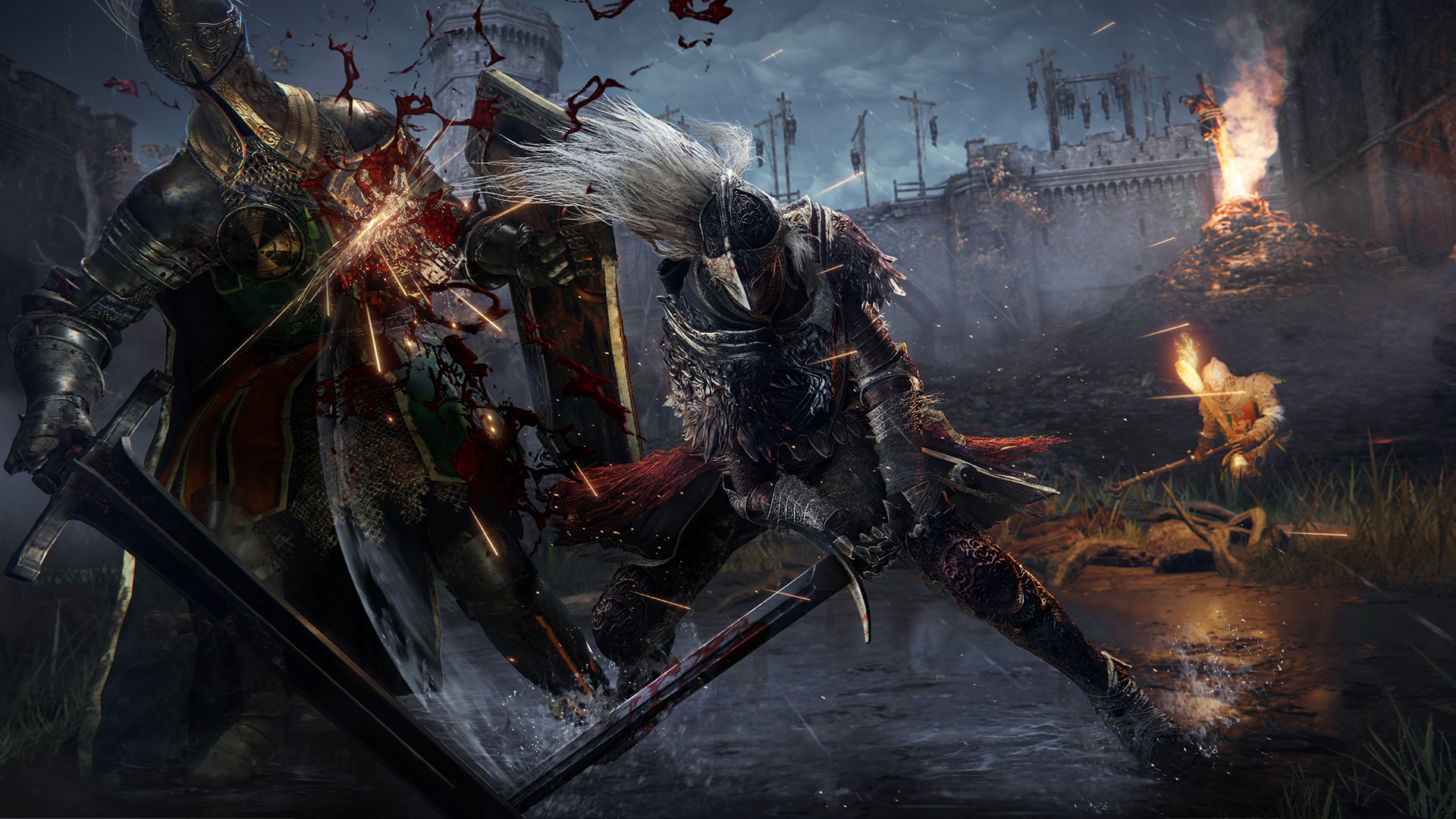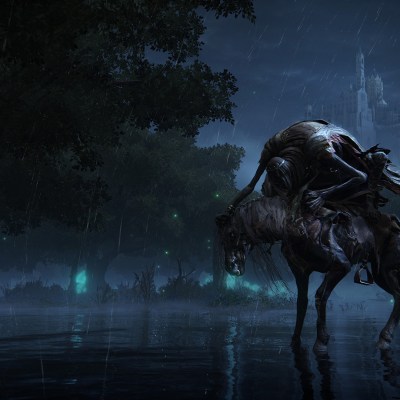There’s no denying that Elden Ring is a hit. According to Bandai Namco, the game has sold over 12 million copies so far, and the title’s critical acclaim really speaks for itself. The only thing more obvious than Elden Ring‘s success is the fact that everyone sees it as the start of gaming’s next big franchise.
Recently, Bandai Namco released a press release that showered the FromSoftware team with praise. The statement commended Hidetaka Miyazaki for marrying his studio’s experience producing Soulsborne titles with George R.R. Martin’s worldbuilding, and the press release concluded by stating, “Please look forward to more of ‘ELDEN RING’ as an IP (characters and other intellectual property) in hopes of expanding beyond the realm of games.”
While the wording was somewhat vague, the message was pretty clear: Bandai Namco has big plans for Elden Ring. Those plans could include everything from tie-in comics and manga to action figures, and, most obvious of all, sequels. Even though Elden Ring is insanely polished (a minor miracle since it is the first open-world Soulsborne title and open-world FromSoftware game) it is far from perfect. A sequel would give FromSoftware the opportunity to implement several of these changes that could make “Elden Ring 2” the kind of game that lives up to an incredible standard.
Elden Ring 2 Should Feature Weirder Weapons
Elden Ring is built around a medieval fantasy world filled with surprisingly standard medieval weapons. While there are a few armaments in the game that simply boggle the mind, there’s always room to go weirder.
As players progress through Elden Ring, they will find plenty of items that sit squarely in the “fantasy” side of “medieval fantasy.” For instance, you have the Coil Shield: a shield-shaped like a snake that can unfurl and shoot poison at enemies. There’s also the Ringed Finger: a gigantic severed finger that hits like a hammer and, strangest of all, can even inflate and flick enemies away.
Regrettably, that is about as weird as weapons get Elden Ring. Admittedly, it’s hard to surpass a hammer that gives new meaning to the phrase “giving someone the finger,” but we’d love to see FromSoftware try. Perhaps a whip made out of a spine? A scythe with a blade shaped like a guillotine? Virtually anything is fair game, especially if those weird weapons help fill out tragically overlooked weapon classes. Reapers and Ballistas need love too!
Elden Ring 2 Should Revive Demon’s Souls’ PvP Boss Fight Concpet
Elden Ring, like other Soulsborne games, lets players invade each others’ worlds to initiate PvP combat, but that’s about where the game’s competitive multiplayer features end. A sequel could expand on that system by reviving a novel PvP mechanic that resulted in one of the most unique boss fights in a Soulsborne game.
FromSoftware’s Demon’s Souls essentially started the whole Soulsborne craze (and genre), thanks in no small part to its collection of memorable bosses. Many gamers remember the Tower Knight and the Storm King, but it’s the battle against the Old Monk that stands out all these years later, largely because players never actually fought him. Instead, gamers battled a random invading player who used their own gear and strategies to fight on the monk’s behalf. This created a chaotic experience since players would battle a different opponent each time (and sometimes serve as the boss). While this idea was dropped for subsequent Soulsborne titles due to balancing and griefing issues, FromSoftware has had over a decade to fine-tune Soulsborne PvP.
Perhaps Elden Ring’s sequel could implement a boss who, much like Demon’s Souls’ Old Monk, relies on invading players to fight for them. After all, Elden Ring is full of segments where an NPC invades a player’s world and essentially behaves like a PvP gamer. A PvP boss fight could be an evolution of that concept. That hypothetical battle could utilize the same updated system that ties invaders to the host’s character and weapon levels. It doesn’t even have to be a mandatory boss battle; just an update to the kind of fight players need to survive to acquire the Great-Jar’s Arsenal talisman.
Elden Ring 2 Needs a True Co-op Multiplayer System
Co-op in non-MMO open-world games is a constant conundrum. If players can explore virtually any location any time they want, how do developers maintain that level of freedom when gamers decide to team up?
Summoning other players is fairly painless in Elden Ring, but it comes with quite a few limitations. For instance, neither host nor summoned help can use their mounts, which effectively restricts co-op to the immediate area. To make matters worse, nobody can enter dungeons or separate areas. If, hypothetically, a player summons help in the open world but needs that person’s aid in Stormveil Castle, they need to dismiss their ally to enter the castle, summon them again inside the dungeon, and then pray they team up with the same player. That restriction not only slows down the pace of the game but weirdly wasn’t present in previous Soulsborne titles.
Ideally, an Elden Ring sequel would feature a more seamless, drop-in/drop-out style of co-op so players can fully explore the world as a team. Games such as Dying Light 2 and Borderlands 3 already utilize forms of that basic co-op system that may not be perfect but also don’t force players to disband. This simple improvement (assuming it is feasible) would make an Elden Ring sequel’s co-op feel much more enjoyable (or at least closer to the co-op in previous Soulsborne titles).
The PC Version of Elden Ring 2 Should be Functional at Launch
FromSoftware’s history with PC ports is…not great. The original PC version of Dark Souls was historically bad, but some fans at the time chalked that up to FromSoftware’s inexperience with PCs. So, when the studio announced Elden Ring, every Soulsborne fan expected FromSoftware to use a decade’s worth of porting experience to create a PC version that ran well from the start. It’s fair to say that’s not exactly what we got.
Even though the Steam version of Elden Ring is far more playable than the original PC version of Dark Souls, Elden Ring was still mired in performance issues. Audiences reported egregious screen tearing, unstable framerates, invisible enemies, and crashes. Elden Ring might be more stable on computers now than it was at launch, but early adopters still had to wait for the game to get there. Given the high-profile release of Elden Ring, we all expected more.
Since Bandai Namco and FromSoftware apparently plan to make Elden Ring their next big franchise, they should try to produce a sequel that is stable across all platforms at launch. There are only so many times a studio can deliver an underwhelming PC port (even if they eventually make up for those mistakes) until audiences lose faith in the company.
Read more
Elden Ring 2 Should Include More Spell Types
Elden Ring has a fairly imaginative library of epic spells. Players can summon thorns of coagulated blood, call down bolts of icy lightning, and unleash a veritable Kamehameha Wave. Despite that initially impressive roster, though, Elden Ring’s magic ultimate feels somewhat lacking in terms of a variety of viable spells and magic builds.
In Elden Ring, magic is divided into Sorceries and Incantations (which scale with Intelligence and Faith, respectively). Previous Soulsborne titles, meanwhile, typically offered a greater vareity of magical options. Dark Souls, for instance, included Sorceries, Miracles, and Pyromancies. While Sorceries and Miracles are fairly self-explanatory, Pyromancies were completely unlike any other spell school. Elden Ring‘s Incantations try to combine Pyromancy abilities and Miracles, but you really start to feel the lack of a dedicated Pyromancer school/class as you realize that Incantations too often serve as a “jack of all trades, master of none” option.
There’s also the matter of how you grow your magic-based character in Elden Ring compared to previous Soulsborne games. In the first Dark Souls, players could only improve spells if they upgraded its catalyst, and in Dark Souls 2, Pyromancy spells scaled with both Intelligence and Faith but didn’t require any minimum stats. That design choice allowed any player to wield Pyromancy abilities to some degree. While that’s technically possible to do in Elden Ring, the stat points required to use some of the game’s more worthwhile spells ultimately demand a more dedicated build that feels at odds with the freedom you’re supposed to be able to enjoy when growing your character.
While not strictly necessary, an Elden Ring sequel could improve on the magic system by incorporating more spell schools (which ideally includes one that mimics Pyromancy’s independence from stat requirements). Not only would that open up more combat options regardless of a player’s build, but it would give From Software a chance to design even more crazy spells.
Elden Ring 2 Should Feature Signifcantly Fewer Repeated Bosses
Since Elden Ring is an open-world title, it obviously has more dungeons and bosses than any other FromSoftware game. That’s a great thing on paper, but in order to fill out a roster of challenging enemies, the studio had two options: run developers ragged by creating a unique boss for every dungeon (as well as several areas in the open world) or create a few bosses and recycle them. FromSoftware obviously opted for the latter.
Simply put, there are a few kinds of boss fights that are repeated too many times throughout Elden Ring. Players have to fight a total of three Mad Pumpkin Heads on their journey, and you’ll eventually battle six Erdtree Avatars if you’re trying to see everything (not including the non-boss variants). As for the Burial Watchdogs…well, the less said, the better.
While some recycled bosses in Elden Ring benefit from minor differences, most players will still end up fighting the same basic enemies again and again. Admittedly, many open-world titles suffer from Elden Ring’s boss recycling problem, but that usually disappears with subsequent entries. You can’t deny that an Elden Ring sequel with improved boss variety would offer a greater challenge. At the very least, nobody wants Elden Ring 2 to repeat Dark Souls 2’s mistake and feature too many humanoid bosses.
Elden Ring 2 Needs to Offer a Better Camera and Improved Controls
Cameras and open-world games rarely get along. The more open and dense a game is, the more likely the camera will “catch” on world geometry and hide important information. Elden Ring is no exception.
Many gamers have reported issues with the game’s camera and its lock-on feature. It’s not uncommon for players to try and focus on one enemy in a group but instead lock onto the wrong opponent. Fighting bosses isn’t much better since the faster ones move too quickly for the camera and cause the thing to start swinging around wildly. Of course, that’s when the camera isn’t glitching out. One Reddit user managed to break the gam’s perspective entirely by jumping off a deadly cliff and quickly double-jumping back. This action tricked the camera into thinking it should utilize a zoomed-in birds-eye view, which made it impossible to navigate. Those problems are par for the course when it comes to open-world games, but most open-world games don’t feature a challenging combat system that requires complete battlefield awareness.
Since Elden Ring is FromSoftware’s first open-world title, we can cut the studio a bit of slack, but that doesn’t mean it should continue making the same mistakes. An Elden Ring sequel should ideally fix the camera to make controlling it less of a chore; the genre is hard enough without having to fight against a camera while also fighting against giant crabs and disembodied hands.
What would you like to see in a hypothetical Elden Ring sequel? Comment down below and let us know.


